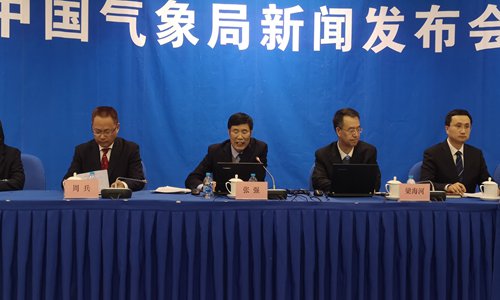Greenhouse gas levels peak in 2017
Global Times
1548209561000
China's average concentration of carbon dioxide (CO2) hit new highs in 2017, but roughly equivalent to the average concentration in northern mid-latitudes, State meteorological agency observational data released on Tuesday shows.

Officials of the China Meteorological Administration and Chinese meteorological experts give speeches at a press conference on Tuesday in Beijing. (Photo: Deng Xiaoci/Global Times)
The China Meteorological Administration (CMA) released its China Greenhouse Gas Bulletin, an annual report on China's state of greenhouse gas situation, at a press conference on Tuesday.Satellite data shows that the global and Chinese averages of CO2 in 2017 were 402 parts per million (ppm) and 405 ppm, respectively, an increase of 2.2 ppm and 2.6 ppm in absolute terms from 2016, largely equivalent to the values over the past eight years from 2010 to 2017.
It also shows that eastern China has the highest average CO2 level at 408 ppm in 2017, while those of southern China and central China are also higher than the country's average.
Based on observational data from the Waliguan background station through 2017, the concentration of methane (CH4), and nitrous oxide (N2O) also hit historical high since 1990 when the observation started, registering 1,912 ppb for CH4 and 330.3 ppb for N2O.
The figures are slightly higher than the global average in all these gases over the same period, but roughly equivalent to the average concentration in northern mid-latitudes, the official report said.
Globally, six satellites are capable of greenhouse gas tracking, and three of them were developed by China, and the data collected by these satellites are open to global users, Fang Shuangxi, deputy head of the atmosphere composition office at the CMA meteorological sounding center, told the Global Times on Tuesday.
The three Chinese satellites are Tansat, China's first scientific exploratory satellite for atmospheric carbon dioxide, launched in 2016, Fengyu-3D polar orbiting meteorological satellite, sent into orbit in November 2017, and Gaofen-5, launched in May 2018, which can track greenhouse gases through payloads based on space heterodyne spectroscopy.
With the help of these satellites, China can understand the greenhouse gas density in China with greater precision, and formulate emissions reduction plans accordingly, and assess how the country is implementing the Paris Agreement, Fang noted.
China has become the third country capable of observing CO2 following Japan and the US, and the CMA has developed primary ground-space integrated monitoring capabilities, according to Fang.
China has always been a key promotor in actively addressing climate change and the implementation of the Paris Agreement, CMA officials told the conference.
Since the 1990s, the CMA has put in place seven atmospheric background stations in the country, including Waliguan station in Southwest China's Qinghai Province, Shandianzi station in Beijing, and Akedala station in Northwest China's Xinjiang Uyghur Autonomous Region, which represent a number of typical climatic, ecological and economic zones in China.
Greenhouse gases including CO2, CH4 and N2O and related tracers have been observed by network stations in a standard and consistent way in response to the Kyoto and Montreal Protocols.
The CMA report pays close attention to the CO2 data as it is the most anthropogenic greenhouse gases in the atmosphere, accounting for around 66 percent of the total radiative force by long-surviving greenhouse gases.


